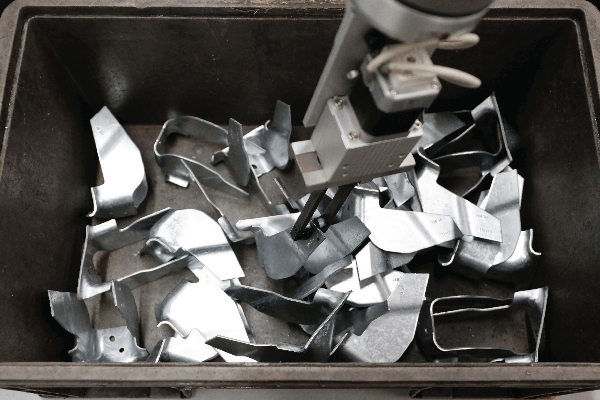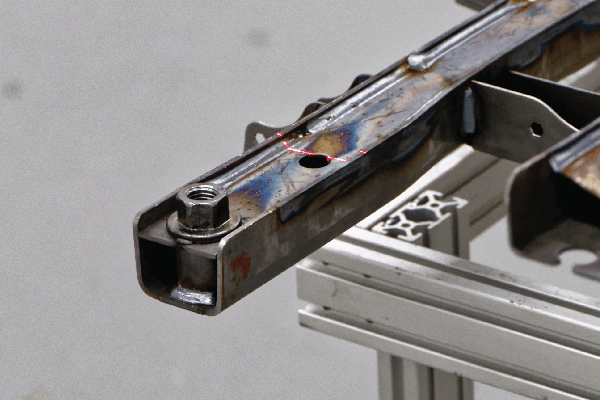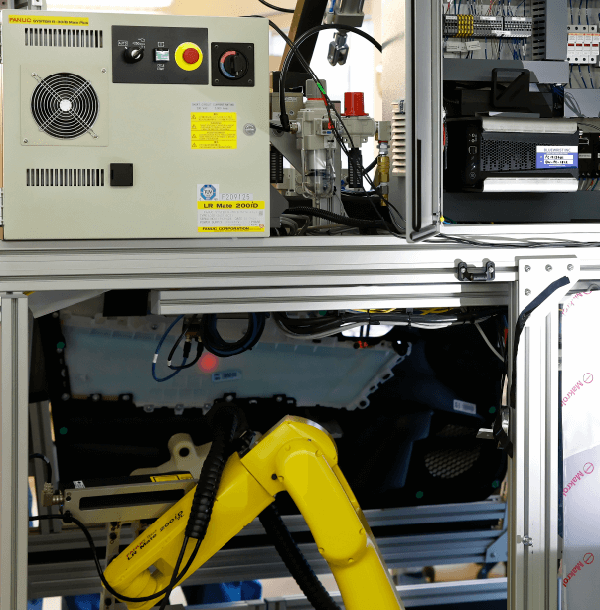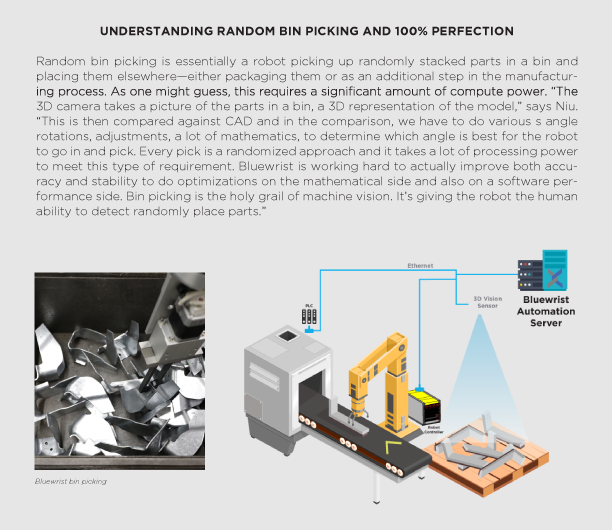Bluewrist Robot & Vison Solutions may sound like a futuristic corporation from Blade Runner or some other sci-fi epic, but in fact, it’s a Canadian-based company every bit as cool as its moniker. Within the realm of robotics and machine vision, Bluewrist produces innovative, software-based, industrial automation solutions, vision inspection systems, robot guidance, and industrial communication products that increase their customer efficiency, improve production quality, and reduce operating costs. Speaking of customers, Bluewrist’s include the likes of Chrysler, Magna, GE, and many more. With multiple projects underway throughout North America and China, the number of Bluewrist employees has doubled over last year.
The company’s computer vison R&D team provides all the algorithms and methodology, the library Bluewrist relies on (they build their own custom library for inspection processes) while their application engineering team consists of PLC experts, mechanical experts, and automation experts to help design or retrofit projects for customers. When customers arrive with their projects, this team will see the requirements and work with R&D to determine feasibility. Bluewrist takes a rigorous scientific approach for all projects so that what the customer wants is feasible with today’s technology and software capabilities. Another key component of their job is customer education. The typical Bluewrist customer (if there is such) has never implemented an automated 3D vision project from start to end, so setting the right expectations is crucial. For Bluewrist, the job is ultimately a balance between speed and quality.


The Bluewrist marketing and communication manager is Jason Niu, a University of Toronto grad who majored in marketing and economics but parlayed his deep technical background and passion for technology products into gigs at AMD, ATI, and Canon prior to joining Bluewrist. “I began my tech career focusing on ink jet printers which led to photography, and video,” Niu recalls. “To process images with more pixels or higher resolution, you need better computers. It all snowballed for me and became the driving force behind my interest in tech because I’m always interested in what’s on the horizon, the next greatest thing. I’ve spent almost a decade in the semi-conductor, hi tech space and now I’ve moved on to another booming industry, industrial automation.”
At Bluewrist, the next greatest thing is often driven by customer demand and according to Niu, those customers, on average, come in two types. The first is starting a manufacturing facility from the ground up, setting up a new plant, and in need of various robotic solutions like robot guidance which instructs the robots to perform specific repetitive tasks. “We help with the guidance,” he says, “and we also marry vision sensors to the robot, enabling it to perform even more complicated tasks such as assembly, loading, or product inspection. In addition, we provide the software infrastructure to enable various industrial devices to communicate with one another.” Because building a modern, automated factory means dealing with a lot of industrial peripherals like PLC, controllers, and sensors, those must be centrally managed. Bluewrist produces the software which enables the programming and ultimately allows the customer to set up a new factory.
Niu says that the second type of customer is well established within an existing facility, but running older equipment in dire need of an upgrade. “We go in and take a look at what they do,” says Niu, “and because our software is hardware independent, we can use it to raise capabilities with minimal disruption to their existing operations.” He also admits that there are definite overlaps between the two types of customers. “Every customer is unique. Everybody makes different products,” says Niu. ”On the other hand, sometimes we have a customer that is creating ten production lines to make the same thing, so every line is pretty much identical. When you talk about different customers, they are usually in different industries with different products, so there are different challenges. But overall, the challenges are often the same.”
All the software applications used by Bluewrist are their own—created in-house and custom. In citing an example, Niu points to a welding video in which the challenge is to maintain the adequate cycle time speed in order to accomplish real-time weld inspections. “A lot of the welding is automated by high speed robots,” he says. “They have a 3D laser profile scanner that will track the weld pattern and our software actually generates a third point cloud off of that pattern and compares that to the weld specs. We do real-time comparison to ensure that there are no gaps, cracks, or other weld defects. So when we deal with a customer like this, we really have to see what the weld speed is. Our software is highly scalable based on the hardware you use to support it. You can scale anywhere from 2 to 22 CPU cores, or as many CUDA cores as you can throw at it.”
Bin Picking Demonstration
Robot Guidance
Niu admits that sometimes Bluewrist is limited by the customer’s budget, as well as power constraints. For example, a customer cannot install a powerful a system on their shop floor because the environment is simply too harsh. In this instance, Bluewrist conducts a lot of internal benchmarking and simulations to determine the optimum sweet spot between the number of CUDA cores and CPU cores, as well as meeting the customer’s speed requirement. “In addition to that, we do our own in-house testing and simulation and run it with various system configurations or with different hardware capabilities to at least match the customer requirements,” says Niu. “So this is our workflow: we take it apart, we do our simulation, feasibility study, and determine the ultimate hardware specifications needed for this project.”
Niu admits that determining the specifications is a challenge, but also one of the easier ones. With the availability of multi-core CPUs and powerful GPUs, Bluewrist’s options are extremely broad. Other key challenges include the accuracy needed, but Niu says that is a whole different discussion. “We always have to balance accuracy and speed,” he says. “You can achieve really accurate scans but you’re dealing with a huge amount of data that will overload even the most powerful system. We have to find a sweet spot in terms of accuracy. With weld inspection, we’re accurate up to 0.1 mm and that’s good enough because welding is typically not that intricate. We’re looking for brazen defects like burn throughs or missing welds which are easy to locate. It’s just a balance of many factors, but ultimately, it boils down to this: Can this be put into a production system? Can we meet the customer’s requirement 24/7? Many factory operations run 24/7.”

For years, the Bluewrist relied on industrial grade PCs, but as inspection processes became more complex (incredibly dense point clouds and higher resolution cameras), the need for processing within a small form factor increased dramatically. Traditional industrial PCs could no longer offer the required level of performance, so Bluewrist began researching alternatives, focusing on form factor, support, and reliability. All roads led to BOXX. Niu even had a ringing endorsement from Adam Glick, a onetime AMD coworker and former BOXXlabs engineer. “Because BOXX is designed, manufactured, and supported in the U.S., we really needed that level of North American support and good service just in case things went wrong—because things always go wrong in manufacturing,” he laughs. “It’s a given factor that things will go wrong, so it’s what you do afterwards that’s the deciding factor of a good or bad service provider. We came to BOXX because their incredibly flexible hardware configurations allow us to scale any number of cores up to the socket limitations.”
This push to move to BOXX was spurred by a specific project. It seems Bluewrist had an extremely challenging project involving one of the top three Japanese OEMs, a company which had an existing type of cell that after two years of trying, they still could not get to work. So they brought it to Bluewrist.
“A lot of our hardware had to be compatible with the existing hardware,” Niu recalls, “and there’s really not much of a physical space for us to work with inside of a control cabinet. There was a lot of stuff—relay switches, power supplies, PLCs, you name it, so we could not use a full-size, industrial strength PC because there was not enough airflow. Secondly, it would not be powerful enough. Only the BOXX APEXX 1* had the small physical size and processing power combination to make this project work.” Bluewrist software developers and engineers conducted performance analysis to determine the best possible hardware configuration and the optimum number of CUDA cores necessary, “It involves the inspection of over sixty different screws and fasteners on a door panel, so we were dealing with a lot of data under ten seconds,” he says. “The APEXX 1 form factor does not exist outside of BOXX, so it was a clear cut decision.”
Internal analysis clearly demonstrated that the BOXX system would deliver the necessary performance, so Bluewrist contacted BOXX MPD Performance Specialist Scott Campbell. They asked some straightforward questions regarding scalability and hardware configurations and came away impressed with Campbell’s knowledge and customer service. “We could spec out the system, but it was Scott who made sure the system was built as soon as possible. Because they were so custom, we really needed to test the performance.” Niu says. The portable powerhouse quickly passed all performance tests and was soon put to work on the project. “Our customer was very impressed when he saw that tiny workstation running that whole cell,” Niu recalls. “The cell basically has a robot arm with two cameras mounted on it and the APEXX 1 is the brains behind it all.”.
Seat Inspection
Weld Inspection
Thus far, Bluewrist has only deployed the APEXX 1 for this specific (and very challenging) project, but Niu says they are looking for more projects where Bluewrist can deploy additional systems. For these professionals, regardless of project, the biggest workflow challenge is speed. “Manufacturing is all about cycle times,” says Niu. “I know on the design side you talk about rendering times, but at the end of the day, if it takes one minute or two minutes, it won’t really break the bank. In manufacturing, if we’re over by one second, we don’t get the project. Sometimes it’s even less than a second. The time factor is really, really critical and that is the single biggest workflow challenge BOXX solves because without the combination of hardware, we would just not be able to do it. We can still inspect it, but if we don’t meet the cycle time requirements, then what we deploy becomes the bottleneck in the plan and they obviously don’t want that. Were helping reduce bottlenecks, but not from a traditional software perspective like in the CAD or 3D animation world where you have to wait for your render to complete. Here, we are solving a real physical problem. This is why I think our story is so unique. We can talk about benchmarks all the time, but everything is software. How fast does this take to compile, to render, etc., but that’s not the case here. We are in a much more critical situation.”

Niu insists that as inspections get more complex with Bluewrist software, the limitation is the camera sensor. Because their software is hardware agnostic, they can use various scanners and sensors available on the market (of which there are many) and their resolution and accuracy increase year by year. It’s the same with the evolution of many electronic components. But to Bluewrist, that also means there is a substantially more data to process. “We are constantly optimizing our software to take advantage of more CPU cores or CUDA cores in order to minimize the cycle requirements,” says Niu, “because with any inspection system, you’re adding another step in the process and also adding overall time to the manufacturing cycle. If we can keep that low, our system becomes extremely competitive. We see more opportunities with BOXX in this scenario because they have the most sensible hardware configurations on the market.”
*The Intel-based APEXX 1 1802 model workstation has since been replaced by the APEXX A1 workstation featuring a 2nd Gen AMD Ryzen™ Processor.
Niu says that with the best software on the market, it takes a few seconds to actually recognize the parts, orientate the robot, and ensure that the robot doesn’t hit the bin or tap the component on the side of the bin. With a tremendous amount of mathematics behind it all, Bluewrist and their competitors are looking for ways to overcome the challenge. In a relatively fragmented industry, companies large and small have their particular strengths. Niu believes Bluewrist’s strength is the fact that they are hardware agnostic. “We can use any sensors, any controllers, any robots,” he says. “Our competitors are more closed ecosystems, so you have to use their sensor, their devices, etc. Our other advantage is our data logging capabilities that enable intelligent, real-time quality data capture and analytics. We provide real-time insight into the manufacturing process through our software (called SPCWorks), so plant managers and quality control techs can have a high level overview of how their manufacturing process is functioning. With SPCWorks, quality information from the shop floor and QA department can result in actionable insights that drive productivity improvement and cost savings across the entire organization. That’s more on the reporting side, not the vision side, but our vision system captures the raw data needed for analysis.”
With all of Bluewrist’s 3D scanning and the inspection, they try to help the manufacturer achieve 100% inspection capability because traditional quality control is done by sampling, where parts are taken off the line at random intervals which can result in bad parts being sent downstream. This can lead to minor problems or in worst cases, very expensive recalls. Through 100% 3D vision inspection, Bluewrist helps eliminate that because all parts are inspected. “Without 3D vision and fast compute time, it’s not possible,” says Niu. “If your inspection becomes a bottleneck, it’s unacceptable. Of course, every manufacturer want 100 percent perfection, but there are limitations you have to overcome. The door inspection project where we relied on the BOXX APEXX 1 was one case where, through education, we became aligned on the same page and we’re still able to deliver a project despite a tight deadline.”